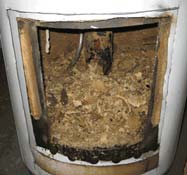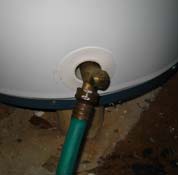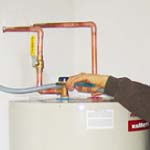How To Properly Water Your Garden Without A Hose
Learn how to properly flush your water heater to improve efficiency and extend the life of your heater
Why do I need to flush my water heater?
 water heater sediment build-up
water heater sediment build-up
You can enhance the efficiency and prolong the life of your water heater by flushing it out. This is especially important if you do not have a water filter on the incoming line of your water supply to your house. Any sediment in the cold water entering the water heater will fall to the bottom of the water heater because it is heavier than the water. In many cases the water heater actually becomes the filter for the hot water lines in your house - which it obviously is not designed to do.
How does this happen, you ask? Even though the water enters the top of the water heater, there is a tube (known as the water heater dip tube) that forces the water to the bottom of the tank. If the water heater did not have this dip tube, then cold water entering the top of the tank would travel straight - directly across the tank to the hot water outlet and you would have cold water in your hot water lines. However, the dip tube also forces any sediment in the cold water to the bottom of the tank also.
 water heater dip tube
water heater dip tube
Sediment build up in the bottom of your water heater tank can reduce the energy efficiency of heating the water because you are heating the sediment along with the water. In gas water heaters the sediment at the bottom of the tank can actually form a layer of insulation between the burner and the water. The sediment slows down the heat transfer from the burner to the water causing the tank to be overheated, weakening the steel and the glass lining. In electric water heaters the lower element can get buried in sediment which can cause it to work far too hard and consequently burn out.
So, to keep your water heater in good working order it is generally recommended you flush the tank and perform all-around maintenance about once a year. However, it is important to note, if you have an older gas water heater and you have never flushed it before, it may NOT be the best idea to do so. Over time the sediment build-up could have caused the steel tank and glass lining to be compromised and some of the sediment could actually be sealing small holes in the steel and flushing out the tank could eliminate sediment that is sealing a leak and cause much bigger problems. If you are at all unsure whether or not you should perform a water heater flush, please contact a local plumbing professional for assistance.
How do I flush my water heater?
Please note: Flushing your water heater is generally a simple task, but there is a significant risk of injury due to contact with excessively hot water and surfaces. Please take all necessary precautions to protect yourself and others, or hire/consult with a plumbing professional before beginning. Additionally, please note that these instructions are general and provided for our customers' convenience only. PlumbingSupply.com® assumes no liability regarding your use of these directions. If you have or can get access to your water heater owner's manual, it is always recommended you follow the manufacturer's instructions specific to your product rather than rely on generalized information.
Step 1. If you have an electric water heater, turn the electrical power to the water heater off at the breaker box. If you have a gas water heater, turn the thermostat to the vacation mode setting or the lowest setting possible without actually turning off the pilot light.
Step 2. Allow the water heater to cool. This can be done by waiting for the heater to cool down for a few hours or someone could take a shower, do laundry, or wash some dishes at this time causing all the hot water to be used up (after, all you already paid to heat it!) and replaced by cold water.
Step 3. Turn the cold water supply to the water heater off - this valve is normally located at the top of the water heater on the INLET side.

Step 4. Connect a garden hose to the drain outlet valve at the bottom of the water heater but do not open the drain valve just yet. Place the other end of the garden hose in a convenient drain location or someplace outside like onto your lawn or garden area. Note that the hose outlet must remain lower than the water level in the tank in order for the water to drain completely out of the water heater.
If you choose to not wait for the water heater to cool, then make sure you use a hose that can withstand hot water. The other end of the hose should be placed where hot water will not harm anything, like children, pets, plants or shrubs, and remember the hose and hose outlet may be too hot to handle with your bare hands.
You can also use a water heater drain pump to speed up the process. Depending on which water heater drain pump you use you can empty a 50 gallon water heater tank within 2-1/2 to 10 minutes instead of waiting for the water heater to drain by gravity.
Step 5. Open the hot water side of your kitchen faucet (or the hot side of any faucet close to your water heater). This will allow air to flow back to the water heater stopping any vacuum in the water heater that will keep the water from flowing out of the drain.
Step 6. Now go back to the water heater drain valve and open it slowly until it is fully open. If you are using a water heater drain pump, turn the pump on after you have opened the drain valve. As the water flows out of the water heater you can let it drain into a clean bucket to see how much sediment is being flushed out. This can help you determine how often you may (or may not) need to flush your system, and also whether or not you might want to consider installing a filtering system.

Step 7. Once the water heater is drained, turn the pump off, if using a pump, and close the drain valve. Open the cold water supply at the top of the water heater and let the water run for 5 to 10 minutes. This can help to dislodge more sediment that may still be in the bottom of the water heater.
Step 8. Turn off the cold water supply at the top of the water heater and again open the drain valve (turn the pump on again if pump is used) and let this water drain out of the tank. Examine the drain water to see if there is still sediment in the drain water or if it is clear. If the water still has some sediment in it then repeat Steps 7 and 8 until the drain water runs clear of any debris.
Step 9. Once you are sure all of the sediment has been drained from the tank then turn off the pump, close the drain valve and remove the garden hose.
Step 10. Now, while the tank is empty, may be a good time to check your Anode Rod and your T&P valve. We suggest you replace the Anode rod if the water heater is over 5-years old. We also suggest you remove and inspect the T&P valve for possible corrosion from certain water conditions and replace it if necessary. If you have a gas water heater you may also want to check the gas vent at this time.
Step 11. When you are ready to refill the water heater, open the cold water supply at the top of the water heater and begin to fill the water heater tank. Check to make sure the drain is closed and does not leak. If the drain valve leaks it could have sediment debris caught inside of it. Turn off the cold water supply at the top of the water heater and clean the debris out of the drain valve. Re-open the cold water supply at the top of the water heater to fill the water heater.
NOTE: If the drain valve is not functioning properly it may also need to be replaced. We suggest you use a 3/4" fipt ball valve with a short pipe nipple. The length of the pipe nipple will depend on how much insulation is used between the water heater tank and the cosmetic exterior cover. Remove the existing drain valve to determine the length of nipple needed to clear the cosmetic cover. A 3/4" ball valve has a larger water way and will allow the water heater to drain much quicker than a regular hose bibb, especially if you have a lot of sediment build-up. You will also need to purchase a 3/4" MHT x 3/4" Mips garden hose fitting to attach to the outlet of the ball valve to be able to add a hose to it if needed in the future.
Step 12. As the water heater fills up, go back to the faucet used in Step 5 to let air into the water heater and let the hot side run until water runs freely through the faucet without releasing air with the water. Turn on a few more faucets (hot side) in the house and let them run until water runs freely there too. If you have a two story house then be sure to open a faucet in an upstairs room as well.
Step 13. Once you are positive all the air has been purged from the water lines and the water heater, you can again start to heat up the water. If your water heater is electric, simply turn the electricity back on to the water heater. If your water heater is natural gas or propane, just turn the thermostat back up to your desired temperature setting.
How To Properly Water Your Garden Without A Hose
Source: https://www.plumbingsupply.com/how-to-flush-your-water-heater.html
Posted by: keslercontold.blogspot.com

0 Response to "How To Properly Water Your Garden Without A Hose"
Post a Comment